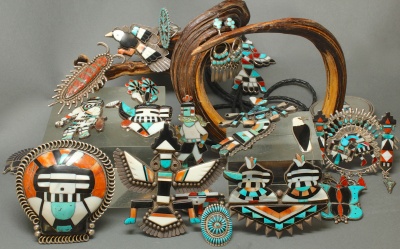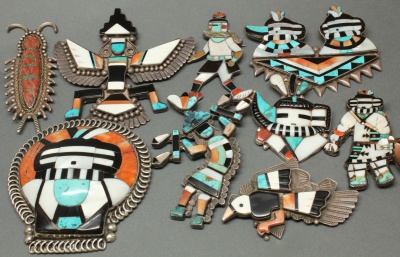Zuni Jewelry Celebration
Having just returned from a research trip to Zuni Pueblo, I am thrilled to offer a thematic presentation celebrating Zuni jewelry. In my opinion, Zuni jewelry is one of the most complex, technically perfect, creative and artistically balanced types of American Indian jewelry ever made, and it is still quite under-appreciated. It is essential that serious collectors of American Indian jewelry become increasingly familiar with Zuni work as it is so well-executed and still quite undervalued. In fact, I’m currently researching for two separate books with Zuni jewelry themes because I believe that the outstanding jewelry is worthy of so much more recognition.
Zuni Pueblo has a population around 10,000 and over 80% of those people work as artists. Zuni artists are best known for their fetish carving and their inlay jewelry, which they’ve been doing for more than 1000 years. In pre-Columbian times, they cut and polished stones and shells and formed patterns by attaching those pieces to wood, bone, or shell backs using the pitch from pinon trees. After the arrival of the Spanish and their introduction of silver, Zuni eventually used silver as the background for their mosaic work. By the early 20th century, Zuni artists began to create the intricate inlay jewelry that we recognize today as mosaic inlay and channel inlay.
Jewelry by the early Zuni masters is superb and sometimes still unmatched today. Three early Zuni artists - Leo Poblano (1905-1959), Teddy Weahkee, and Lambert Homer, Sr. are recognized as being the greatest mosaic jewelry artists, but there are other traditional greats as well like Frank Vacit, Juan de Dios, Dan Simplicio, John Gordon Leak (or Leakity). It is important to note that these people were working entirely by hand, doing their lapidary work with basic tools like pump drills and hand grinders. Most of the greats did not have electricity until the 1950’s or later. Think of that for a moment, and then this walking katsina pin becomes even more of a remarkable feat.
The skill it takes to produce something like this large Knifewing pin is just astounding. The amount of work is immense. Every single little stone has to be cut out by hand and placed in an original colorful mosaic pattern that fits together seamlessly. In my opinion, Zuni jewelry has not yet received its just due, but it will certainly arrive in time. If you look at any other kind of Southwestern American Indian jewelry, it has already seen a great deal of appreciation. Hopi pieces by Charles Loloma, one of my specialties, can command prices at upwards of $50,000. In contrast, my most expensive Zuni piece is this unparalleled Zuni Shell Pin with Inlay Kachina for $7800. $7800 is a bargain for a piece of such quality! Yes, for now in Zuni jewelry, there are still bargins to be had. This Horace Iule Knifewing God Pendant is just wonderful and only $275. Considering Horace Iule was the originator of the Knifewing figure in Zuni inlay, a bargain indeed. We also have an inlay pendant by Leonard Martza for under $150. Yes, Leonard Martza of C.G. Wallace Collection fame. Yes, for under $150!
While my collection is quite heavy in the old masters, it really spans the spectrum from this magnificent old unattributed centipede pin to a few present-day works like this reinterpretation of a traditional Knifewing figure by present-day artist Harlan Coonsis. This vintage Albert and Dolly Banteah bolo of a cardinal shows how much more realistic the subjects of Zuni jewelry have become. This Zuni corn plant pin/pendant shows the originality that has been expressed in Zuni jewelry.
In closing, please do take a moment to appreciate Zuni jewelry. I believe that you will come away feeling enriched for so doing. If you’d like to study Zuni jewelry further, I recommend the following books as great resources:
1. Zuni A Village of Silversmiths by James Ostler, Marian Rodee and Milfod Nahohai
2. Knifewing and Rainbow Man in Zuni Jewelry by Toshio Sei
3. Hopi Bird and Sunface in Zuni Jewelry by Toshio Sei
4. C. G. Wallace Auction Catalog (If you are lucky enough to find one!)
View Zuni Jewelry at Martha Hopkins Struever Gallery



